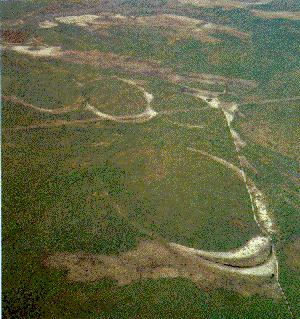

William F. Prouty's (a former head of the University of North Carolina geology department) contention (1952) that the Carolina Bays were formed by an impact event has not been refuted by direct evidence nor has it been tested by more modern methods. Recently, however, several papers have been published that relate evidence which could be viewed as supportive of Prouty's hypothesis. For instance, P.S. Martin's "over-kill" scenario is in trouble due to finds of mammoths in Europe which date 5,000 years younger than earlier discovered specimens. This closes the gap between the youngest date for mammoths in America (10,500 B.P.) and for Europe (12,000 B.P.) to 1,500 years (see G.R. Coope and A.M. Lister, Nature Vol. 330, 3 Dec. 87, pp. 472-474).
The reduction of the temporal difference between finds on these two continents suggests that the megafauna extinction may have been synchronous in the northern hemisphere and related to the Younger Dryas cold event. Evidence is growing that this glacial readvance occurred abruptly (see E. Bard, et al., Nature Vol. 328, 27 Aug. 87, pp. 791-794) and was also felt in the southern hemisphere (C.J. Heusser and J. Rabassa, Nature Vol. 328, 18 Aug. 87, pp. 609-611). There is also suspicion that an atmospheric C-14 anomaly (discussed by E. Bard et al. cited above) may have occurred during this period. A large impact could explain the climate phenomena and account for a C-14 anomaly (see J.C. Brown and D.W. Hughes, Nature Vol. 268, 11 Aug. 77) which, if real, would have been greater around the area of impact (North America), which would in turn cause fauna in this region that survived the initial event to absorb a greater amount of C-14 and so date younger than fauna less exposed, thus further reducing the temporal difference between finds in Europe and America. Although Prouty's physical model of how the bays were formed is probably flawed, considering the above, it is certainly becoming more likely that his basic contention was correct. For an excellent review of the controversy over the origin of the Carolina Bays see The Mysterious Carolina Bays (1982) by Henry Savage.
Home More Bays (27k) Distribution of Bays (58k) Recent images of Bays close to Myrtle Beach, South Carolina (180k)